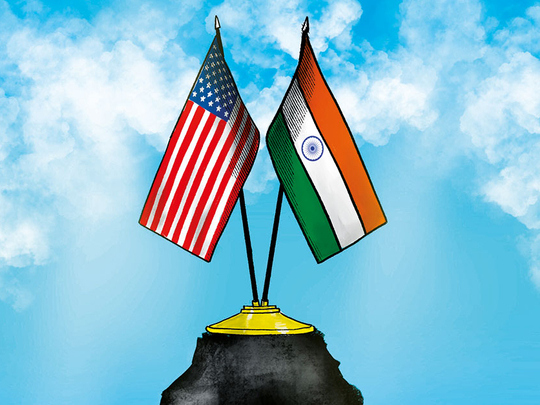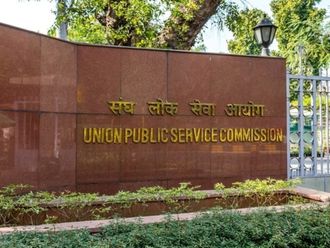
India and the United States will hold their first comprehensive dialogue on September 6 in Delhi, called 2+2, which was agreed to by United States President Donald Trump and Indian Prime Minister Narendra Modi last year. This dialogue will involve India’s ministers of external affairs and defence, Sushma Swaraj and Nirmala Sitharaman, respectively, and their US counterparts, Mike Pompeo and James Mattis, respectively.
Addressing the media at the US State Department’s Foreign Press Centre, Alice Wells, the principal deputy assistant secretary for South and Central Asia, described the 2+2 dialogue, which had been twice postponed previously, as an “important opportunity” to foster closer ties between the two countries. US experts talk about “operationalising” India as a major defence partner.
“Operationalising”, in layman’s terms, casts India as a lucrative market for US defence equipment. Indo-US defence cooperation today is worth some $18 billion (Dh66.20 billion) and the US defence industry sees huge potential to get lucrative contracts from India.
Wells spoke about intensifying bilateral cooperation in a range of diplomatic and security priorities, underscoring the 2+2 dialogue as a deepening of the strategic partnership with India, and embracing a broad range of bilateral, regional and global issues of shared interest aimed at strengthening bilateral security ties, adding that India is “enshrined in US President Donald Trump’s national security strategy”.
Wells clarified that the partnership was not going to be based on defence acquisitions but on how “we see (global) challenges and how we are able to respond to these challenges”.
However, it is no secret that the Trump administration would like to use defence, aviation, energy and technology to increase US exports and reduce the trade imbalance currently in India’s favour. Bilateral trade in 2017 was at $126 billion, surging $10 billion over the previous year. Indeed, former undersecretary of commerce in the Obama administration, Stefan Selig, had once told me in an interview that he anticipated Indo-US trade increasing to $500 billion “in a few years”.
Nevertheless, Americans say that realising full potential of two-way trade is contingent upon India removing tariffs and non-tariff barriers and intellectual property rights issues that preclude a balanced surge in two-way trade. The US is holding talks with India, according to Wells, on how to “unlock the trade that is of great interest to US firms when they look at the Indian market and its potential”.
Responding to my question, Wells said that the US is also willing to work with India on projects outside India, reminding that both had partnered in third countries, including in Africa, Afghanistan, etc. She spoke of taking this partnership to a “new level” beyond defence ties.
The 2+2 dialogue will also dwell on new emerging actors on the world stage. New Delhi will, invariably, raise the issue of India-centric terrorism emanating from Pakistan. Washington has been prodding Pakistan to take steps to eradicate terrorism from its soil. Pompeo will visit Islamabad to feel the pulse of new Prime Minister Imran Khan’s government before heading for the 2+2 dialogue in New Delhi.
China’s growing assertiveness in the South China Sea and, indeed, in the global arena will come up for discussion. India, as part of the Quadrilateral Security Dialogue — the other three members of the Quad being Australia, Japan and the US — will be urged to play a more active role in the group’s engagement in the Indo-Pacific — including the South China Sea. The Quad is an effective part of Washington’s Indo-Pacific strategy. The US, according to Wells, conducts more military exercises with India than with any other country in the world.
However, the conspicuous softening in India’s attitude towards China, following recent meetings between Prime Minister Narendra Modi and Chinese President Xi Jinping, particularly after their Wuhan summit, has made some US experts sceptical about India’s willingness to play an effective role in the Quad theatre. They wonder whatever became of India’s fierce resistance last year against Chinese encroachments in the Doklam area at the Bhutan borders.
Indeed, some US security experts have even called for stopping the “velvet-glove treatment” that Washington gives to India.
Mattis intervened to get India exempted from the Russia sanctions law called Countering America’s Adversaries Through Sanctions Act (CAATSA), despite the anti-Russia sentiments in Congress and the Democratic Party.
Iran is another touchy issue for Americans who may feel uncomfortable at India’s flirt with the ayatollahs. However, most experts believe that the US will either delay punitive sanctions against India or simply look the other way on India’s commercial dealings with Iran.
The US also granted special access to India on nuclear technology, clearly snubbing China, which blocked India’s entry in the Nuclear Suppliers Group. The US also helped India get admitted to three other groups, the Missile Technology Control Regime, the Wassenaar Arrangement and Australia Group.
Nevertheless, taking defence and foreign policy cooperation to the next level is slow. If Washington wants to intensify its defence cooperation with India, the former clearly needs to spell out the kind of technology it will impart to India while New Delhi, on its part, should break out of its “bullock-cart mindset”, as some US experts privately say.
Both sides have to recognise and surmount their shortcomings if they are to attain the prized relationship they are striving to achieve.
Manik Mehta is a New York-based journalist with extensive writing experience on foreign affairs, diplomacy, global economics and international trade.








